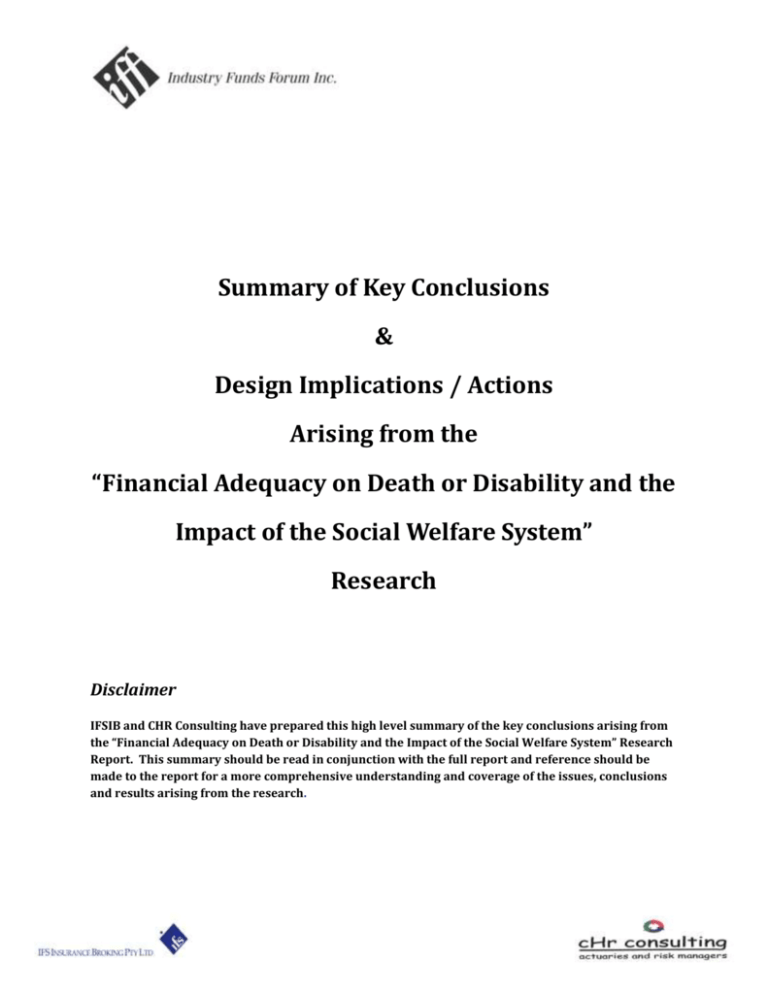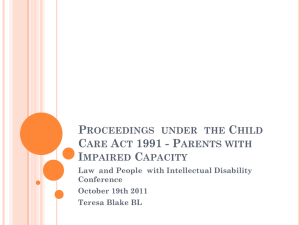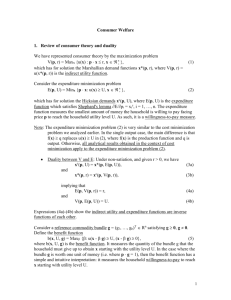Financial Adequacy on Death or Disability and the
advertisement

Summary of Key Conclusions & Design Implications / Actions Arising from the “Financial Adequacy on Death or Disability and the Impact of the Social Welfare System” Research Disclaimer IFSIB and CHR Consulting have prepared this high level summary of the key conclusions arising from the “Financial Adequacy on Death or Disability and the Impact of the Social Welfare System” Research Report. This summary should be read in conjunction with the full report and reference should be made to the report for a more comprehensive understanding and coverage of the issues, conclusions and results arising from the research. Adequacy Research Summary In summary the adequacy research undertaken on behalf of Industry Funds Forum (IFF) examined the following: 1. The formulation of a benchmark for the determination of an Adequate Amount of income, for the average working Australian, in the event of the person’s premature death, or temporary / permanent disability in order to protect pre retirement income and saving for post retirement income; and 2. The extent of any gaps that may exist between the Adequate Amount and benefits provided by the social welfare system; and 3. The broad Insurance design implications that come out of the research that Trustee’s may consider for their funds. 1. Adequate Amount – Key Conclusions The research defined the Adequate Amount as the level of household income required to maintain an adequate living standard of the person and their dependants in the event of premature death or disability. Two levels of adequacy where examined - Tier 1 aimed to ensure that the financial security of a household was maintained at a similar level to that which existed prior to death or disablement, while Tier 2 aimed for a more fundamental level, which provides for basic household expenditure needs only. It was established that the Adequate Amount is not a singular set dollar amount that is universally applicable to all working Australians. The amount differs depending on the event, i.e. whether it is death or disability, and takes into consideration a number of key elements including; maintenance of household expenditure in real terms (indexed in line with AWOTE); maintenance of adequate retirement savings levels; allowances for the meeting of transitional costs, and for the provision of care (disability only). The research considered the position of people in different financial circumstances, different family structures (i.e. singles, couples with no children, couples with children) and in the case of death the age and gender of the surviving partner and the likelihood of remarriage. The main conclusions reached include: For both death and disability, the Adequate Amount varied significantly by household income and household family structure, reflecting expenditure patterns prior to the death or disablement. In particular, couples with children required higher amounts of future income. The Adequate Amount in the event of premature death varied significantly with the age of the surviving spouse, (with higher amounts required at younger and middle age brackets), and the gender of the surviving spouse, (with higher amounts required for males than for females), and the age and number of any dependent children. For disability (excluding singles) the Adequate Amount generally varied proportionately with household income. Notably for singles, a large proportion of the ‘severe’ disability Adequate Amount relates to the cost of ongoing care (Tier 1 only). For couples this responsibility was assumed to be undertaken by the spouse. 2. Basing the Adequate Amount on the repayment of debt or financing school fees is a sub-optimal approach as these areas of expenditure (mortgage repayment and school fees) are relatively minor as a proportion of total expenditure. Social Welfare System – Key Conclusions The research confirmed that the Australian Social Welfare System is extremely complex and for the most part inefficient. For the majority of households it is ineffectual as a means to finance the Adequate Amount even under the basic adequacy test. The post event income available to households with no personal exertion income or net assets is very low (in the range of 2% to 25%) regardless of whether the household includes children. The financial gap between the Adequate Amount and Social Welfare benefit entitlements is substantial and households will face severe financial disruption in the event of either death or disability (including moderate disability), if Social Welfare is the only source of financial support. The Social Welfare System is also inadequate for reasons other than financial reasons, including the use of CPI for indexation of benefits rather than AWOTE, onerous asset and income test requirements, the absence of encouragement of return to work, difficulty to requalify for previous benefit(s), unfavourable tax treatment of any personal exertion income earned whilst in receipt of a benefit and severe penalties that may apply where personal circumstances change resulting in overpayment, regardless of fault. The system creates for most people an unknown and unknowable benefit, leading to the need to have specialist organisations to assist people in managing their access to entitlements. 3. Design Implications and Actions for Funds to consider The research, while not directly aimed at benefit design, did reveal some design issues that Trustees may consider for their Fund: Increase the Fund’s general understanding of their membership, by undertaking profile analysis of the Fund’s existing data base to improve knowledge about the makeup of the membership including age profile, gender profile, income levels, cover levels, family structure and occupational profile. Membership research through survey’s and focus groups can also assist in gaining a better understanding of member attitude to insurance, premium tolerance / elasticity and member perception of needs. Improved understanding of the Fund’s membership profile will enable the Fund to align benefit levels, (including default cover) with the Adequate Amount requirements most appropriate to their membership profile by utilising the Research results and taking into account the types of households and income levels of the membership and the potential impact of Social Welfare benefits; In aligning benefit design with the needs of the membership consider whether the Fund should separate Death and TPD cover. Separation of the death & TPD benefits could enable the Fund to better target member needs, particularly when catering for the needs of various household groups, i.e. Singles, Couples and Couples with children; Consider whether it may be more appropriate for death benefits to be paid as an income stream rather than as a lump sum or the possibility of providing financial planning advice in conjunction with the payment of large lump sum death benefits, to assist the surviving spouse to best manage benefits to ensure long term financial security; Consider the need to introduce/enhance default Income Protection benefits to better cover the needs of disabled members, in particular the possibility of long term Income Protection arrangements. This would reduce the reliance on lump sum TPD. Focus TPD benefits to meet one off transition costs which are much higher for the severely disabled, who are the only members who will qualify to access TPD benefits. In addition these benefits could also be used to finance on going member care needs particularly for severely disabled single members; Ensure that Income Protection arrangements include a superannuation contribution replacement component to provide for long term saving needs. Review existing income protection arrangements and approach the insurer to remove the Social Welfare benefit offset under the policy, if one exists. These offsets make the Social Welfare and income protection benefit for the disabled member uncertain and the member risks spending money that they are not entitled to. Review any existing Fund calculators, or consider developing a Calculator, to assist members with determining their insurance needs using the methodology as set out in the research. Alternatively work with groups such as IFF to assist in developing such a calculator. The calculator could incorporate the Social Welfare benefits structure to enable members to gain an understanding of the extent to which the Social Welfare system may meet their personal financial needs in the case of death or disablement and therefore the importance of any insurance coverage that they may be able obtain through their superannuation Fund. Strengthen member engagement and communication strategies to ensure a better understanding of the concepts surrounding the Adequate Amount and the implications of not having adequate cover.










